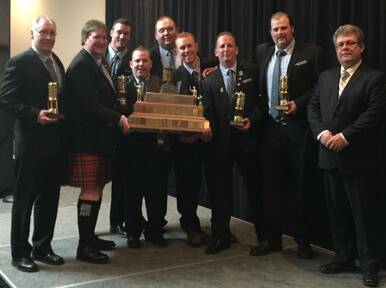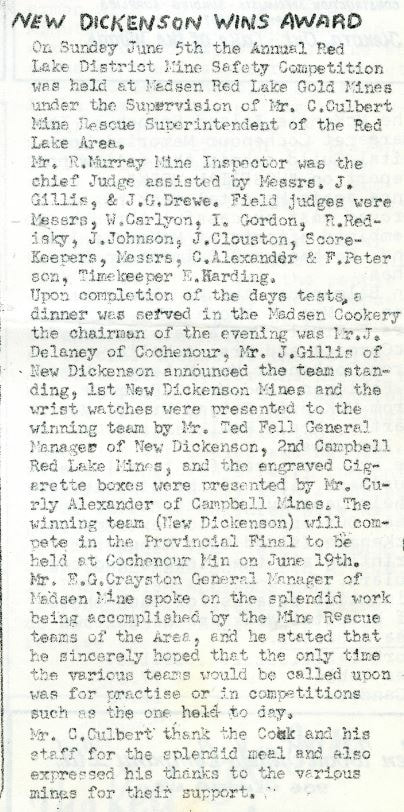The Ontario government created Ontario Mine Rescue (OMR) in the wake of the 1928 Hollinger Mine fire in Timmins, Ontario. The mine and the town were not capable of fighting the fire, so mine rescue teams were called in from Pittsburg, PA. The blaze was eventually put out, but 39 miners perished. After the tragedy, a provincial royal commission was undertaken to determine how the deaths could have been avoided. The result of the commission was the creation of OMR in 1929, under the umbrella of the Department of Mines. Today, OMR is part of Workplace Safety North and 2019 marks OMR's 90th anniversary.
Red Lake is one of eight mine rescue districts in Ontario, where OMR regulates the training of volunteer first responders in mine rescue efforts. As first responders, mine rescue teams fight fires, rescue injured personnel and respond to a wide range of incidents.
Red Lake is one of eight mine rescue districts in Ontario, where OMR regulates the training of volunteer first responders in mine rescue efforts. As first responders, mine rescue teams fight fires, rescue injured personnel and respond to a wide range of incidents.
|
Training Today, there are four qualifications that potential mine rescue volunteers must meet. They must:
OMR requires potential members to complete a 40-hour basic training course. A significant part of this course is seeing if volunteers can use a breathing apparatus. On top of this introductory course, mine rescue teams are continually training to keep their skills sharp and learn new standards. District Mine Rescue Officers provide six training sessions a year to complement individual study. |
Mine Rescue
|
|
Equipment
The primary piece of equipment that mine rescue operators use is the breathing apparatus. When OMR began the McCaa self-contained oxygen apparatus. The McCaa had a two-hour capacity and was used by OMR until the mid-1960's. The Dräger BG174, which had a four-hour breathing capacity, replaced the McCaa. OMR teams used the Dräger BG174 for almost 40 years before replacing it with the Dräger BG4 that mine rescue teams use today. Gas detection technology and rescue stretchers have been mainstays in the mine rescue equipment since its foundation. Historically, the primary gas detection instrument was the flame lamp. The flame within the lamp reacted to the conditions around it, alerting mine rescue officers to the presence of gas or lack of oxygen. Today, mine rescue teams use digital gas detectors. The main difference between historic and modern rescue stretchers is the material. Historically, the stretchers were made from metal, whereas today they are made out of much lighter fibreglass. The design of the bucket-like stretcher has also become boxier. Other standard equipment includes hydraulic spreader, hydraulic bolt cutters, foam generator, lifting bags, hydraulic splitter, thermal imaging cameras and radios. |
|
Teams
Ideally, mines have three five-member teams (primary, reserve and backup). Individual teams usually have five people: a Captain; #2 man (carries the gas detector); #3 man (carries the first aid kit); #4 man (carries a spare breathing apparatus); and a Vice Captain. The Captain assigns tasks and ensures the safety of team members. The underground team is supported by a briefing officer, who briefs and monitors the team while acting as a liaison with management. If an emergency is severe, a rotation of nine teams is formed. Competitions Mine rescue teams compete regionally, provincially and even internationally to encourage high standards, show off their skills and support ongoing training. Teams have to work their way through a scenario, such as a fire or a rescue. They are scored based on their quality of work and adherence to standards. Historically these competitions were held underground but moved to the surface in the late 1960's. For more information on mine rescue visit the Ontario Mine Rescue website. |
From the Newsroom...
Timeline
Historic Red Lake Mining
Red Lake Geology
The Red Lake Gold Rushes
From Hudson to Headframe
Community Development
Commerce
Education
Medicine
Recreation
Mining Practices
Going Underground
Equipment
Extraction
Milling
The Mill Process
Safety
Refuge Station
Mine Rescue
Health Issues
Jobs
Contemporary Red Lake Mining
Environment
Labour
Innovation
Exploration
Indigenous Rights
Gold Prices
Mining and Exploration Companies
Goldcorp Inc.
Rubicon Minerals
Premier Gold Mines
Pure Gold Mining
Rimini Exploration & Consulting
Other Mining & Exploration Companies
Glossary






